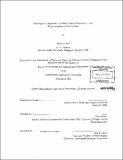From space to episodes : modeling memory formation in the hippocampal-neocortical system
Author(s)
Káli, Szabolcs, 1972-
DownloadFull printable version (18.72Mb)
Alternative title
Modeling memory formation in the hippocampal-neocortical system
Other Contributors
Massachusetts Institute of Technology. Dept. of Brain and Cognitive Sciences.
Advisor
Peter Dayan.
Terms of use
Metadata
Show full item recordAbstract
This thesis describes the use of mathematical, statistical, and computational methods to analyze, in two paradigmatic areas, what the hippocampus and associated structures do, and how they do it. The first model explores the formation of place fields in the hippocampus. This model is constrained by hippocampal anatomy and physiology and data on the effects of environmental manipulations on the place cell representation. It is based on an attractor network model of area CA3 in which recurrent interactions create place cell representations from location- and direction-specific activity in the entorhinal cortex, all under neuromodulatory influence. In unfamiliar environments, mossy fiber inputs impose activity patterns on CA3, and recurrent collaterals and perforant path inputs are subject to graded Hebbian plasticity. Attractors are thus sculpted in CA3, and are associated with entorhinal activity patterns. In familiar environments, place fields are controlled by the way that perforant path inputs select amongst the attractors. Depending on training experience, the model generates place fields that are either directional or non-directional, and whose changes when the environment undergoes simple geometric transformations are in accordance with experimental data. Representations of multiple environments can be stored and recalled with little interference, and have the appropriate degrees of similarity in visually similar environments. (cont.) The second model provides a serious test of the consolidation theory of hippocampal-cortical interactions. The neocortical component of the model is a hierarchical network structure, whose primary goal is to extract statistical structure from its set of inputs through unsupervised learning. This interacts with a hippocampal component, which is capable of fast learning, cue-based recall, and off-line replay of stored patterns. The model demonstrates the feasibility of hippocampally-dependent memory consolidation in a more general and realistic setting than earlier models. It reproduces basic characteristics of retrograde amnesia, together with some related phenomena such as repetition priming. The model clarifies the relationship between memory for general (semantic) and specific (episodic) information, suggesting that part of their underlying substrate may be shared. The model highlights some problematic aspects of consolidation theory, which need to be addressed by further experimental and theoretical studies.
Description
Thesis (Ph. D.)--Massachusetts Institute of Technology, Dept. of Brain and Cognitive Sciences, 2001. Includes bibliographical references (p. 171-196).
Date issued
2001Department
Massachusetts Institute of Technology. Department of Brain and Cognitive SciencesPublisher
Massachusetts Institute of Technology
Keywords
Brain and Cognitive Sciences.